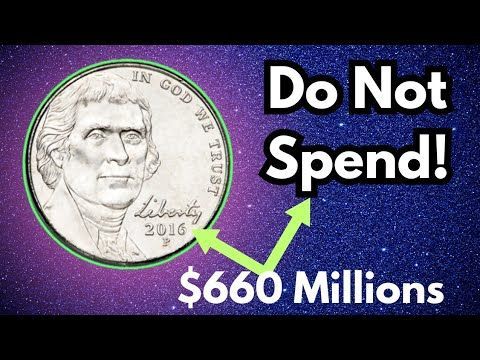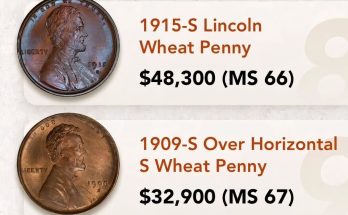The humble five-cent coin, or nickel, is perhaps the most overlooked piece of American pocket change. While billions of Jefferson Nickels circulate today, the numismatic history of this small denomination is a thrilling saga of legendary rarities, startling mint errors, and colossal values that can reach into the millions. The caption, “Most Valuable and Expensive Nickels USA coins!,” is not hyperbole, but a gateway into a world where a single five-cent piece can become a collector’s ultimate prize. The most valuable US nickels belong to three major series: the Liberty Head, the Buffalo, and select rare varieties of the Jefferson series.
The Crown Jewel: The 1913 Liberty Head Nickel
The undisputed king of all US nickels, and one of the most famous coins in American numismatics, is the 1913 Liberty Head Nickel. This coin transitioned American coinage from the Liberty Head V-design to the iconic Buffalo Nickel design in 1913. However, the change was not entirely smooth: only five examples of the 1913 Liberty Head design were ever struck, and all were produced under mysterious, unauthorized circumstances.
This extreme rarity has cemented the coin’s legendary status. Each of the five known specimens has a name and an incredible history of sales, setting and breaking coin auction records for decades. The highest recorded price for this coin is a staggering $4.56 million, achieved in a 2018 auction for the Eliasberg specimen, which is graded Proof-66. The mystery surrounding the coin’s mintage, coupled with its near-mythical scarcity, ensures it remains a perennial favorite among elite collectors, making it the most valuable and expensive US nickel by a monumental margin.
The Wild West of Nickels: Buffalo Rarities
The Buffalo Nickel, officially known as the Indian Head Nickel, was minted from 1913 to 1938 and is highly popular among collectors. Within this brief series lie numerous “Key Dates” and varieties that command prices well into the six figures.
- 1926-S Buffalo Nickel: With a mintage of only 970,000 pieces from the San Francisco Mint, this is considered the undisputed key date of the series. Its low survival rate in high grades is what drives its value, with one pristine example selling for $322,000.
- 1918/7-D Buffalo Nickel: This coin features a significant overdate error where the “8” in the date was stamped over a previously punched “7”. This dramatic error from the Denver Mint has seen specimens reach prices up to $350,750.
- 1937-D “Three-Legged” Buffalo Nickel: One of the most famous and recognizable mint errors in US coinage, this variety resulted from an over-polishing of the coin die, which mistakenly removed the bison’s front leg on the reverse. Collectors highly seek this iconic error, with the highest auction price recorded at nearly $100,000 for a high-grade example.
- 1916 Doubled Die Obverse: This variety features dramatic doubling on the date and the Indian Chief’s features, a result of a die production error. This coin can command prices near $281,750.
Jefferson Nickels: Errors and Key Dates
Even the modern Jefferson Nickel series (1938–Present) holds its share of multi-thousand-dollar rarities, proving that great value can be found even in the most recent coinage.
- Wartime Silver Nickels (1942–1945): Due to the use of nickel metal for the war effort, the alloy of the five-cent coin was temporarily changed to 35% silver and 56% copper. These are easy to spot, as they feature a large ‘P’ (for Philadelphia, the first time a ‘P’ mint mark was used on a circulating US coin), ‘D’, or ‘S’ mint mark placed above the dome of Monticello on the reverse. While most are only worth their silver content, special proofs and errors can be highly valuable, such as the 1942 Proof Frith specimen, which sold for $175,000.
- 1943-P 3 Over 2 Overdate: A striking error from the Wartime series where the ‘3’ in the date was punched over a visible ‘2’, creating an unmistakable variety highly desired by collectors, with values reaching over $16,450 in high grades.
- 1950-D: This coin is valuable not for an error, but for its low mintage of just over 2.6 million pieces, making it a key date for the series.
- “Full Steps” Designation: For collectors of top-grade Jefferson Nickels, the “Full Steps” (FS) designation is paramount. This means all six steps leading up to Monticello on the reverse are fully and sharply struck. A perfect example, such as a high-grade 1940, can command over $21,000.
The incredible values associated with these US nickels demonstrate that true numismatic value often lies not in the metal content, but in the confluence of rarity, historical significance, and the dramatic mistakes of the minting process. An error or a scarce date can transform a common five-cent piece into a priceless artifact, inspiring generations of collectors to keep their eyes peeled for “The Million Dollar Nickel”.



